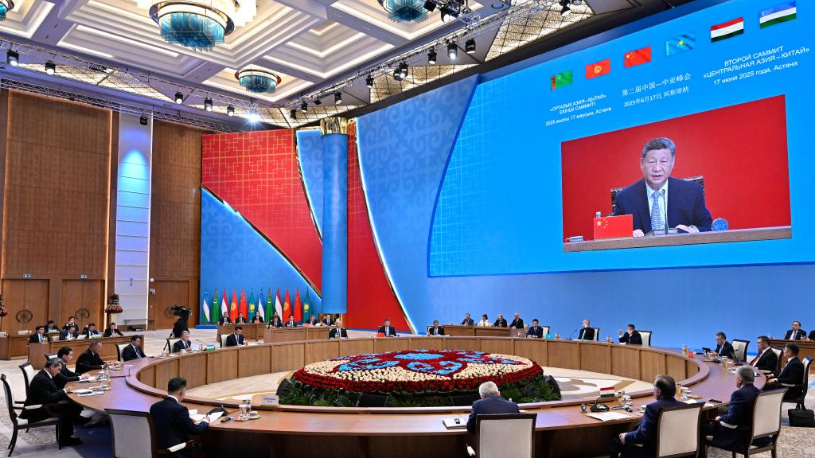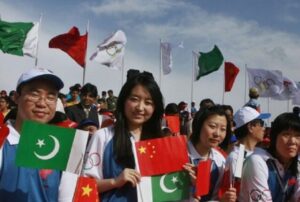China and the Geopolitics of Central Asia

The Second China-Central Asia Summit, held in Astana, Kazakhstan, with the prominent presence of President Xi Jinping, marks a turning point in China’s evolving foreign policy and its vision for a more interconnected and multipolar world. Convened amid intensifying regional conflicts such as the Iran-Israel war and broader shifts in Middle Eastern geopolitics, the summit reaffirms Beijing’s expanding role as both a regional stabilizer and a global peace broker. The Astana Declaration, adopted at the conclusion of the summit, provides a concrete outline for cooperation grounded in principles of mutual respect, sovereignty, and development-driven diplomacy. It is not merely a diplomatic milestone but a symbolic gesture of China’s counter-hegemonic posture in global affairs, offering an alternative vision to Western-centric approaches.
The Declaration emphasized regional stability, sustainable development, mutual economic growth, and the shared pursuit of peaceful coexistence. It reaffirmed commitments to uphold the sovereignty and territorial integrity of all nations, support for the UN Charter, non-interference in internal affairs, and rejection of unilateral sanctions and power politics. Most importantly, the summit prioritized alignment with the United Nations Sustainable Development Goals (SDGs), especially in poverty reduction, climate change, clean energy, and cross-border connectivity, which are critical for long-term peace and prosperity in Central Asia and beyond.
China’s Belt and Road Initiative (BRI), central to this partnership, continues to serve as a strategic platform linking China to Kazakhstan, Uzbekistan, Turkmenistan, Kyrgyzstan, and Tajikistan. As of 2024, China has invested over $100 billion in Central Asia in energy pipelines, road and rail infrastructure, digital technology, and industrial cooperation. These initiatives are not limited to economic gains; they represent a structural transformation of the region’s geopolitical alignment. China’s approach to development is less conditional than that of Western-led financial institutions, offering an appealing alternative for states wary of liberal interventionism.
This strategic depth must be understood in the global context of power transition and systemic crisis. While the United States and its allies maintain military presence and influence through NATO, AUKUS, and QUAD, especially in the Indo-Pacific and South China Sea, their developmental outreach often remains tied to governance reform, conditional aid, and geopolitical leverage. The Astana Summit and China’s presence in Central Asia reflect a different model: development-led peacebuilding rooted in state sovereignty, infrastructure, trade, and mutual security.
The US-Japan alliance and US military infrastructure across Asia, including 54,000 troops in Japan and over 28,000 in South Korea, contrast sharply with China’s soft-power expansion. Simultaneously, the US continues to deepen ties with Israel, supplying $3.8 billion annually in military aid, and maintaining unwavering political support, which has alienated much of the Global South amid the current Israel-Iran-Palestine crisis. In South Asia, this conflict has deepened polarization — countries like Pakistan, Iran, and Turkey vocally support Palestine, while others tread cautiously. China, in contrast, has advocated for a two-state solution, ceasefire, and multilateral diplomacy, consistent with its foreign policy ethos of “peaceful development.”
This approach can be situated within the theoretical framework of Marxism with Chinese characteristics, wherein economic development is a prerequisite for peace, and the state assumes a guiding role in shaping equitable modernization. China’s engagement in Central Asia follows this logic, while respecting local autonomy, it mobilizes state resources and strategic investments to build infrastructure, stabilize economies, and foster long-term cooperation. Unlike Western liberalism that often promotes civil society as a check on state power, China privileges state-to-state cooperation as the vehicle for development.
The United States has traditionally maintained global hegemony through a combination of coercive power (military bases, economic sanctions) and ideological consent (liberal democracy, human rights discourse), China is developing a counter-hegemonic model, a “new historical bloc” in which development, multipolarity, and respect for national models replace the universalism of Western liberal norms. China’s discourse of “win-win cooperation,” “shared future of mankind,” and “community of common destiny” resonates with many post-colonial and developing countries seeking alternatives to Western-dominated globalization.
Subaltern and postcolonial perspectives on international politics highlight that countries in Central Asia, historically caught between Russian imperialism, Soviet control, and post-9/11 US incursions, now find agency through diversified partnerships, particularly with China. While Western narratives often describe Central Asia as a battleground for great powers, or a fragile zone prone to authoritarianism and extremism, China’s developmental diplomacy offers the region a way to reclaim its historical position as a connector of civilizations, as it once was on the ancient Silk Road.
This ideological divergence is increasingly visible in Western geopolitical discourses. Western think tanks and policy elites often criticize China’s presence in Central Asia as expansionist or neo-colonial. They warn of “debt-trap diplomacy” and lack of transparency. However, these critiques often ignore the developmental needs and agency of Central Asian nations themselves, many of which view China’s investments as critical lifelines for industrialization, digitalization, and energy security. Moreover, the Chinese approach of offering development without demanding regime change or political liberalization is seen as more respectful by many in the Global South.
At a broader level, the Astana Summit reflects the emerging global polarization between Western hegemonic structures and the multipolar alliances centered around China, Russia, and parts of the Global South. While Russia remains a key player in Central Asia due to historical, linguistic, and military ties, its declining economic power post-Ukraine invasion has created space for China’s ascent. Still, Sino-Russian cooperation remains strong, especially within multilateral institutions like the Shanghai Cooperation Organization (SCO), BRICS+, and various energy forums. Their relationship is best described as “strategic coordination without ideological convergence.” China’s dominance is more economic and technological, while Russia retains influence through security and culture.
Simultaneously, China’s rise is not without contradictions. Its internal issues,from surveillance policies in Xinjiang to debt management with weaker states, remain concerns. However, its model of developmental peace, as showcased at the Astana Summit, offers a real and functional pathway to achieving the United Nations SDGs, particularly, SDG 1 (No Poverty) through targeted investments in rural infrastructure, SDG 7 (Clean Energy) via cross-border pipelines and solar projects, SDG 9 (Industry, Innovation and Infrastructure) through BRI corridors, SDG 16 (Peace, Justice and Strong Institutions) through multilateral cooperation, SDG 17 (Partnerships for the Goals) by forming equitable, inclusive regional institutions.
Moreover, the Declaration’s emphasis on inter-civilizational dialogue, cultural cooperation, and people-to-people exchange highlights a broader vision for global peace rooted not in coercion but in mutual understanding and common development.
In conclusion, the Second China-Central Asia Summit illustrates the tectonic shifts underway in the global order. China is not just a regional actor seeking influence; it is an ideological, economic, and geopolitical force shaping the architecture of a new world order. Through diplomacy, development, and institutional outreach, it is accelerating a multipolar world that resists binary divisions and prioritizes shared prosperity. The summit’s declaration, deeply aligned with the SDGs and the principles of global dignity, charts a course toward peace and justice that stands in contrast to the militarized, polarized, and often exclusionary policies of the existing global hegemon.
As we confront escalating crises from military conflicts to climate emergencies, the need for critical thinking, dialogue, and pluralistic cooperation has never been more urgent. The road ahead must be paved not by unilateral impositions or zero-sum games, but by inclusive frameworks that respect diversity, enable sovereign agency, and center development as the foundation of peace. In this, China’s engagement in Central Asia, though complex and evolving, offers a compelling model of how global power can be reimagined in service of humanity not dominance.


